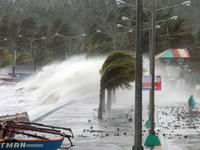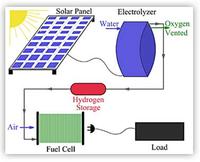-
U.S. power plant emissions down

Power plants that use natural gas and a new technology to squeeze more energy from the fuel release far less of the greenhouse gas carbon dioxide than coal-fired power plants do, according to a new analysis. The so-called “combined cycle” natural gas power plants also release significantly less nitrogen oxides and sulfur dioxide, which can worsen air quality.
-
-
Nearby Georgia basin may amplify ground shaking from quakes in Vancouver
In Greater Vancouver, there are more than 700 12-story and taller commercial and residential buildings, and large structures — high-rise buildings, bridges, and pipelines — which are more affected by long period seismic waves, or long wavelength shaking. Researchers find that tall buildings, bridges, and other long-period structures in Greater Vancouver may experience greater shaking from large (M 6.8 +) earthquakes than previously thought due to the amplification of surface waves passing through the Georgia basin.
-
-
Coastal flooding in Ireland offers warning of things to come
Flooding in Ireland and the U.K. is typically associated with heavy rainfall, but the reason for more recent coastal flooding is different. Experts say that the increases in mean sea level suggests that mean sea-level rise rather than storminess is largely contributing to the dramatic increase in the frequency and scope of coastal flooding. Major cities like Cork, Dublin, and Galway will soon feel the impact of sea-level rise, and developers are discouraged from building within 100 meters of soft shoreline.
-
-
Tidal energy could provide half of Scotland’s power needs

A stretch of water off the north coast of the United Kingdom could provide enough energy to power about half of Scotland, engineers have found. Researchers have completed the most detailed study yet of how much tidal power could be generated by turbines placed in the Pentland Firth, between mainland Scotland and Orkney. They estimate 1.9 gigawatts (GW) could be available.
-
-
Growing threat of intense tropical cyclones hitting East Asia

The intensity of tropical cyclones hitting East Asia has significantly increased over the past thirty years, according to a new study. The coastlines of China, Korea, and Japan in particular have experienced increasingly stronger cyclones, which the researchers have attributed to increasing sea surface temperatures and a change in atmospheric circulation patterns over the coastal seas.
-
-
Carbon nanotube sponge helps in water clean-up
A carbon nanotube sponge capable of soaking up water contaminants, such as fertilizers, pesticides, and pharmaceuticals, more than three times more efficiently than previous efforts has been presented in a new study published today. The carbon nanotube (CNT) sponges, uniquely doped with sulphur, also demonstrated a high capacity to absorb oil, potentially opening up the possibility of using the material in industrial accidents and oil spill clean-ups.
-
-
New L.A. fault map threatens Hollywood development projects
The state of California recently released new geological maps which reveal the presence of an active earthquake fault along the path of major developments in Hollywood. The maps established a zone of 500 feet on both sides of the fault, and state law will require new developments within the zone to conduct underground seismic testing to determine whether the fault runs beneath planned development sites. Building on top of faults is prohibited. Three prominent Hollywood developments — the Millennium Hollywood skyscraper project, the Blvd6200 development, and an apartment project on Yucca Street — are within the 500-foot fault zone.
-
-
Healthcare industry to conduct cyberattack drill in March
The American health care industry, in partnership with the federal government, will in March conduct simulated cyberattacks targeting industry networks and resources in an effort to test the industry’s vulnerability to cyberattacks. This will be the first time insurers, hospitals, pharmaceutical manufacturers, and HHS will run coordinated drills. Healthcare is one of seventeen critical infrastructure sectors which, if attacked, could have damaging consequences for the country.
-
-
Massachusetts takes steps to withstand climate change impacts
Governor Deval Patrick of Massachusetts earlier this week unveiled a $50 million plan to help prepare Massachusetts for the challenges climate change poses to energy supplies, public health, transportation, and basic infrastructure in his state. A $40 million grant from the state’s Department of Energy Resources will help cities and towns develop protections around energy services, and $10 million will go toward shoring up critical coastal infrastructure and dam repair.
-
-
Aging natural gas pipelines leak under Washington, D.C. streets
More than 5,893 leaks from aging natural gas pipelines have been found under the streets of Washington, D.C., a team of researchers finds. A dozen of the leaks could have posed explosion risks, the researchers said. Some manholes had methane concentrations as high as 500,000 parts per million of natural gas — about ten times greater than the threshold at which explosions can occur.
-
-
NRC: storing spent nuclear fuel in cooling pools is safe
The nuclear reactors now in service in the United States were built with the assumption that the spent fuel would be removed from nuclear the facilities after a few years, but because the government has failed to provide a centralized place to store the spent fuel, utility companies have had to store an ever-growing quantity of it in spent fuel pools on the grounds of the facilities. Scientists argue that it would be safer to move some of the spent fuel into giant steel and concrete casks, where it can be stored dry, with no reliance on water, pumps, or filters to keep them cool. The nuclear industry and the NRC do not agree.
-
-
The causes of recent Caribbean earthquakes
A 6.4-magnitude earthquake shook Puerto Rico Monday 13 January. It caused some power outages and cracked floors, but no major damage or injuries were reported. The quake, which struck the northern coastal town of Hatillo, is one of the largest to hit the U.S. territory in recent years. This event comes four days after a 5.0-magnitude earthquake rattled Havana, Cuba. Researchers say that the earthquake in Puerto Rico occurred on the North American-Caribbean plate boundary, whereas the earthquake in Cuba happened well inside the North American plate. Although inter-plate earthquakes do occur, often on older faults that are reactivated, they are less common than those that form at plate boundaries.
-
-
Harnessing solar energy during day for use at night

In one hour, the sun puts out enough energy to power every vehicle, factory, and device on the planet for an entire year. Solar panels can harness that energy to generate electricity during the day. The problem with the sun, however, is that it goes down at night — and with it the ability to power our homes and cars. If solar energy is going to have a shot at being a clean source of powering the planet, scientists had to figure out how to store it for night-time use. Researchers have built a system that converts the sun’s energy not into electricity but hydrogen fuel and stores it for later use, allowing us to power our devices long after the sun goes down.
-
-
Estimating the best time to launch a cyberattack
Of the many tricks used by the world’s greatest military strategists, one usually works well — taking the enemy by surprise. It is an approach that goes back to the horse that brought down Troy. But surprise can only be achieved if you get the timing right. Timing which, researchers at the University of Michigan argue, can be calculated using a mathematical model — at least in the case of cyber-wars. “The question of timing is analogous to the question of when to use a double agent to mislead the enemy, where it may be worth waiting for an important event but waiting too long may mean the double agent has been discovered,” the researchers say.
-
-
Using building “belt” cheaply, quickly to repair of earthquake damage
Four years after the January 2010 earthquake, 145,000 people still remain homeless in Haiti. Researchers developed a cheap and simple technology to repair earthquake damaged buildings to help to reduce these delays by quickly making buildings safe and habitable. The technology involves wrapping metal straps around each floor of the building, which are then tensioned either by hand or using compressed air tools. Unlike other repair methods, it does not require expensive materials or a high level of technical knowledge, making it ideal for use in the developing world.
-
More headlines
The long view
Water Wars: A Historic Agreement Between Mexico and US Is Ramping Up Border Tension
As climate change drives rising temperatures and changes in rainfall, Mexico and the US are in the middle of a conflict over water, putting an additional strain on their relationship. Partly due to constant droughts, Mexico has struggled to maintain its water deliveries for much of the last 25 years, deliveries to which it is obligated by a 1944 water-sharing agreement between the two countries.
Trump Is Fast-Tracking New Coal Mines — Even When They Don’t Make Economic Sense
In Appalachian Tennessee, mines shut down and couldn’t pay their debts. Now a new one is opening under the guise of an “energy emergency.”
Smaller Nuclear Reactors Spark Renewed Interest in a Once-Shunned Energy Source
In the past two years, half the states have taken action to promote nuclear power, from creating nuclear task forces to integrating nuclear into long-term energy plans.
Keeping the Lights on with Nuclear Waste: Radiochemistry Transforms Nuclear Waste into Strategic Materials
How UNLV radiochemistry is pioneering the future of energy in the Southwest by salvaging strategic materials from nuclear dumps –and making it safe.
Model Predicts Long-Term Effects of Nuclear Waste on Underground Disposal Systems
The simulations matched results from an underground lab experiment in Switzerland, suggesting modeling could be used to validate the safety of nuclear disposal sites.
